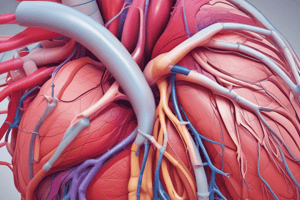Podcast
Questions and Answers
What is the normal range for Mean Arterial Pressure (MAP)?
What is the normal range for Mean Arterial Pressure (MAP)?
- 70-105 mmHg (correct)
- 50-80 mmHg
- 80-110 mmHg
- 60-120 mmHg
If a patient has a BP of 70/50 mmHg, what is their MAP and is organ perfusion adequate?
If a patient has a BP of 70/50 mmHg, what is their MAP and is organ perfusion adequate?
- 70, adequate
- 56, inadequate (correct)
- 60, adequate
- 66, adequate
What does the Cardiac Index (CI) measure?
What does the Cardiac Index (CI) measure?
- The heart's electrical activity
- Cardiac output relative to body size (correct)
- Oxygen saturation in the blood
- Blood volume pumped per heartbeat
If a patient has a cardiac output (QT) of 8.5 L/min and a body surface area (BSA) of 3 m², what is their Cardiac Index (CI)?
If a patient has a cardiac output (QT) of 8.5 L/min and a body surface area (BSA) of 3 m², what is their Cardiac Index (CI)?
What is considered an adequate cardiac output (QT) at rest?
What is considered an adequate cardiac output (QT) at rest?
What effect does the sympathetic nervous system have on the heart rate?
What effect does the sympathetic nervous system have on the heart rate?
Which term describes the volume of blood returning to the right atrium each minute?
Which term describes the volume of blood returning to the right atrium each minute?
What happens during diastole?
What happens during diastole?
Which of the following factors can lead to an increased heart rate?
Which of the following factors can lead to an increased heart rate?
What is considered a normal ejection fraction range?
What is considered a normal ejection fraction range?
What does preload refer to in the context of heart function?
What does preload refer to in the context of heart function?
Which system is responsible for pupil constriction?
Which system is responsible for pupil constriction?
What is pulse pressure?
What is pulse pressure?
Flashcards
Mean Arterial Pressure (MAP)
Mean Arterial Pressure (MAP)
Average pressure within the arteries during a single cardiac cycle. Normal range is 70-105 mmHg. A MAP below 60 mmHg indicates inadequate organ perfusion.
MAP Calculation
MAP Calculation
MAP is calculated as: (2 x Diastolic Blood Pressure + Systolic Blood Pressure) / 3.
Cardiac Index (CI)
Cardiac Index (CI)
CI measures the heart's pumping efficiency relative to body size. It indicates if the cardiac output is adequate for the patient's body surface area.
CI Calculation
CI Calculation
Signup and view all the flashcards
Cardiac Output (QT)
Cardiac Output (QT)
Signup and view all the flashcards
Sympathetic Nervous System
Sympathetic Nervous System
Signup and view all the flashcards
Parasympathetic Nervous System
Parasympathetic Nervous System
Signup and view all the flashcards
Ejection Fraction (EF)
Ejection Fraction (EF)
Signup and view all the flashcards
Preload
Preload
Signup and view all the flashcards
Afterload
Afterload
Signup and view all the flashcards
Contractility
Contractility
Signup and view all the flashcards
Pulse Pressure
Pulse Pressure
Signup and view all the flashcards
Study Notes
Mean Arterial Pressure (MAP)
- Normal range is 70-105 mmHg
- Less than 60 mmHg indicates inadequate organ perfusion
- Calculation: MAP = (2 x Diastolic Blood Pressure) + Systolic Blood Pressure / 3
Cardiac Index (CI)
- Measurement assessing the adequacy of cardiac output relative to the patient's size
- Normal range is 2.5-4.0 L/min/m²
- Calculation: CI = Cardiac Output (QT) / Body Surface Area (BSA)
- Higher CI values are needed for larger patients
Cardiac Output (QT)
- Represents the volume of blood pumped by the left ventricle per minute
- Calculation: QT = Stroke Volume (SV) x Heart Rate (HR)
- Normal range: 4-8 L/min at rest
Sympathetic Nervous System
- Releases norepinephrine (NE)
- Increases heart rate and electrical impulses
- Affects all areas of the heart
- Converts glycogen to glucose
- Causes pupil dilation and fight-or-flight response
Parasympathetic Nervous System
- Releases acetylcholine (ACH)
- Reduces electrical impulses
- Decreases heart rate
- Affects the AV nodes
- Causes pupil constriction
- Associated with "rest-and-digest" functions (e.g., salivation, lacrimation, urination, defecation, bronchospasm, bradycardia)
Systolic vs. Diastolic
- Systole: top number of blood pressure (BP)
- Normal range is 90-120 mmHg
- Semilunar valves open, AV valves close
- Ventricles contract
- Diastole: bottom number of blood pressure (BP)
- Normal range is 60-90 mmHg
- Semilunar valves close, AV valves open
- Ventricles relax
Venous System
- Crucial for returning blood to the heart
- Acts as a reservoir for blood
- Approximately 60% of total blood volume is contained in venous system at any given time
- Venous return should equal cardiac output (QT)
Ejection Fraction (EF)
- The percentage of blood ejected from the ventricles with each heartbeat
- Normal range is 65-70%
- Below 50% indicates reduced cardiac function and can limit exercise tolerance
Preload, Afterload, Contractility
- Preload: Ventricular stretch before contraction; affected by filling, compliance, venous return, and end-diastolic volume
- Afterload: Resistance to ventricular emptying; affected by peripheral vascular resistance (PVR), ventricular wall tension, and viscosity/volume of blood
- Contractility: Strength of ventricular contraction; influences cardiac output
Pulse Pressure
- Difference between systolic and diastolic blood pressure
- Normal range is 30-40 mmHg
- Low pulse pressure may indicate low stroke volume
Central Venous Pressure (CVP)
- Measures pressure in the right atrium
- Normal range is 2-6 mmHg; higher CVP suggests fluid overload
Positive Pressure Ventilation (PPV)
- Method of mechanical ventilation that increases pressure in the lungs
- Augments preload and cardiac output; can also lead to hazards like increased intracranial pressure (ICP)
Pulmonary Artery Wedge Pressure (PAWP)
- Measurement of pressure in the Left atrium
- Normal range is 5–10 mm Hg
Studying That Suits You
Use AI to generate personalized quizzes and flashcards to suit your learning preferences.




